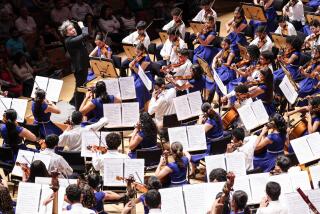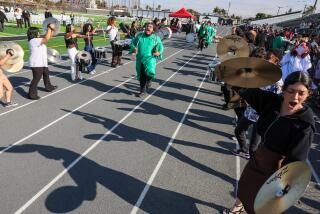When Making Music for the Soul, Itâs All Elementary
I WAS IN MY 30S WHEN, WEARY OF POPULAR MUSIC, WITH ITS LOW nutrient count and constant morphing of fashions, I began to listen to classical.
I started with easy Baroque fare. Many a Sunday afternoon of cooking unfolded against the aural background of Bachâs âBrandenburgâ Concertos and Handelâs âWater Musicâ suite. Further into it--Mozart and Beethoven, Brahms and Mahler, Vaughn Williams and Britten--the stuff became something you couldnât make meatballs to. You had to sit down, clear your mind and really pay attention, not just once but many times.
It wasnât so much a matter of grasping the music as of making yourself available for it to grasp you. When that happened, it could transport you to the most profound and complex feelings--joy, sorrow, fulfillment, loss--without the corrupting intervention of language. âMusic is the speech of the soul,â I later heard a music teacher explain.
What Chan Ho Yun is doing on a Monday afternoon in a donated second-floor meeting room in South-Central doesnât look like it has much to do with the speech of the soul.
âIâm not looking for pretty sound yet,â he tells the five violin-bearing elementary-schoolers arrayed before him. âIâm looking for correct posture.â
Yun drills them in âthe rest positionâ (feet together, eyes straight ahead, violin tucked under right arm, bow dangling from right hand) and âthe playing positionâ (feet apart, left heel pointing at right arch, violin under chin, left hand on neck of violin and aligned over left elbow and left foot).
A small, antic man, Yun is not above getting down on the floor with his charges and crawling from one to another to adjust how theyâre holding their bows.
He leads them through an exercise involving six bow strokes on the open E string, done to the chant âMis-sis-sip-pi-Hot-Dog,â with emphatic strokes on the âHotâ and the âDog.â
âOh, that sounds so ugly, but so beautiful too,â Yun tells the kids. âYou guys did fantastic. Whatâs your homework for next week? A clean âMississippi Hot Dog.â A clear difference between âMississippiâ and âHot Dog.â â
The kids are beginners in a visionary 2-year-old program called Sweet Strings, of which Yun is volunteer music director. The brainchild of community activist Kika Keith, it provides youngsters with group and individual instruction, and envisions a full-blown youth orchestra in South-Central in five years.
While the students in Yunâs beginning class are struggling with basic mechanics, more advanced students are playing minuets and other sophisticated fare. Sweet Stringsâ beginners and veterans together have already played the Hollywood Bowl (they performed âTwinkle, Twinkle, Little Starâ and received a tearful standing ovation).
South-Centralâs response has been remarkable. Currently, 116 children, ages 5 to 17, participate. More than 250 are on a waiting list.
âHip-hop and R&B;, these kinds of music come naturally to them,â Keith says of the mostly African American and Latino students. âLearning classical music, however, requires discipline and opens them up to a different world, to something that historically these children never have been exposed to. The classical music itself is nice, but Iâm really in it to see lives transformed.â
Sweet Strings relies heavily on donated instruments, but demand has outrun supply. Much of the organizationâs annual budget-- $192,000, thanks to grants from the likes of the Ahmanson and Gap foundations--goes to buying instruments (the rest pays for those instructors who are not volunteers).
Last month, for example, Sweet Strings had to buy 12 new cellos, 14 new flutes and 25 new violins. Having begun cello and flute instruction last fall, it will introduce viola lessons in the spring.
Sweet Strings is thriving in an encouraging context. In California and elsewhere, music education, especially for young children, is receiving new emphasis in the public schools. This is a response to studies that show learning music is salutary to childrenâs brain development and their performance in reading and other subjects.
The California State Board of Education is currently implementing its first standards for education in music and other arts. In 1999 the Los Angeles Unified School District embarked on a 10-year plan that would see each of the districtâs 451 elementary schools having instruction in music and other arts for at least one full day each week.
At present, California lags behind other states. Thanks to budget cuts during the 1980s, the state employs one music teacher for every 1,400 public-school students. The national average is one to every 700.
Personally, Iâd love to see children like the Sweet Strings kids become future devotees of classical music, because I think it moves the soul like no other and makes for an especially rich appreciation of existence. I realize, though, that the personal discipline, sense of accomplishment and new brain pathways forming as they saw their way through âMississippi Hot Dogâ are ultimately more important than whether they grow attached to Schubert or Debussy.
On the other hand, maybe some will--and they wonât have to have waited till they were almost old enough to be president before they had a clue.
More to Read
The biggest entertainment stories
Get our big stories about Hollywood, film, television, music, arts, culture and more right in your inbox as soon as they publish.
You may occasionally receive promotional content from the Los Angeles Times.










